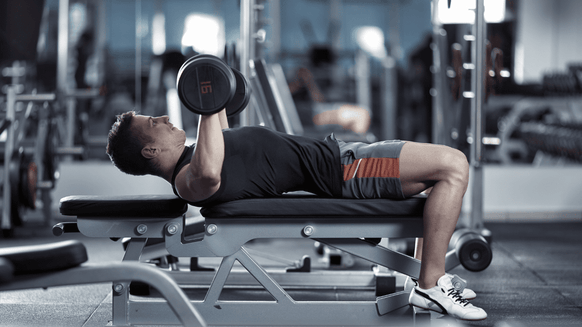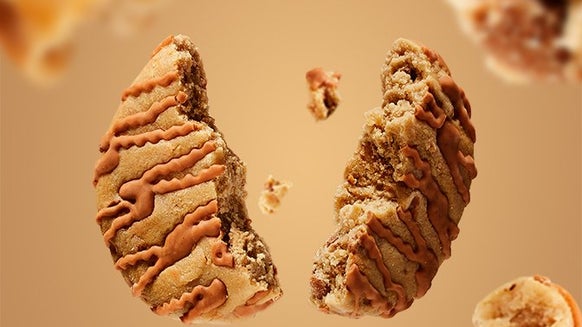
One of the most sought-after muscle groups for feats of strength and aesthetics is a well-developed chest. The chest muscles consist of the pectoralis major and minor, which respond to resistance training like any other muscle group, but some may struggle to achieve the results they desire more than others. In this article, we’ll help you address your issues with some key training tips.
How to Safely Pick Up Dumbbells
Before handling heavy dumbbells in any chest press exercise, you should feel comfortable at getting them into the starting position and putting them down safely on your own.
Unlike in barbell presses, you won’t be able to rack the weight, so you may need to count on a spotter to lift the weight off your chest – or know how to ditch the weight safely by yourself. Throwing or swinging a dumbbell carries a great risk of injury to both yourself and the precious floor. So, what’s the best way to pick up dumbbells yourself?
Grab a pair of dumbbells and sit down on a bench, placing the dumbbells atop of your thighs. Make sure that your grip is firm and that your hands are facing each other. Lie back on the bench whilst pushing the dumbbells up with your thighs. Position the dumbbells above your chest while placing your feet on the floor. Make sure that your chest is pushed up, your shoulders retracted (pulled back) and that your upper back and buttocks touch the bench at all times.
Chest Day Exercises
1. Dumbbell Bench Press
This exercise is arguably the most effective free-weight movement for development of stubborn pecs. Dumbbell presses allow for better pecs contraction as you can bring the dumbbells together at the top of the movement (known as adduction, one of the primary movements of the pectoralis major). They also allow for greater range of motion in comparison to barbell bench presses – this is especially true for people with short arms and wide rib cages.
To start, lie down on a bench and bring the dumbbells above your chest. Twist your wrist so that your thumbs are facing each other (pronated grip). Position your arms in line with your shoulder with slightly bent elbows. Slowly lower your arms and spread your elbows as far as possible. Hold the stretch for a second and use your chest to bring your arms up and close together in a triangle-like motion. Do not allow the dumbbells to touch each other at the top. In order to allow greater muscle contraction, tilt your wrists outwards so that your thumbs are pointing slightly upwards. Squeeze your chest and hold the contraction for a 1-2 seconds
2. Twisting Dumbbell Bench Press
The twisting dumbbell bench press is a rarely seen exercise, which fully exploits the non-fixed grip advantage of dumbbells.
The 90° rotation of the dumbbell throughout the movement aims to stimulate all the muscle fibre bundles of the pectoralis major. Twisting the dumbbells will force you to use less weight than in regular presses. Therefore, you shouldn’t focus on hitting your personal bests on this movement. Instead focus on perfect muscle isolation.
To start, lie down on a bench and bring the dumbbells above your chest. Twist your wrist so that your thumbs are facing each other (pronated grip). Position your arms in line with your shoulder with slightly bent elbows. Slowly lower your arms and spread your elbows as far as possible. The key difference here, is that you rotate the dumbbell so that you end with a neutral grip at the bottom (palms facing in towards each other), rotating back to a pronated grip as you press back to the start position. Hold the stretch for a second and use your chest to bring your arms up and close together in a triangle-like motion. Do not allow the dumbbells to touch each other at the top. In order to allow greater muscle contraction, tilt your wrists outwards so that your thumbs are pointing slightly upwards. Squeeze your chest and hold the contraction for a 1-2 seconds
3. Crush-Grip
Lie down on a bench and bring the dumbbells above your chest. Twist your wrist so that your pinkies face each other. This is known as a supinated grip. Position your arms in line with your shoulder and slightly bend your elbows – contract your chest and press the dumbbells against each other, forcing even more powerful contraction. Slowly detach the dumbbells from each other trying to maintain the chest contraction – lower your arms, spreading your elbows apart similarly as in regular dumbbell bench press. Whilst lowering the dumbbells, slowly turn your wrists, so that your thumbs face each other (pronated grip) once reaching the bottom part of the movement. Hold the stretch for a second and use your chest to bring the arms back up, again slowly twisting your wrists to a supinated grip at the top of the movement – at his point squeeze your chest and press the dumbbells together and hold the contraction for 1-2 seconds
4. Dumbbell Flyes
Dumbbell flyes are the bread and butter of most chest training programmes, and for a good reason! They allow for an intense loaded stretch. When performed correctly, the exercise is an amazing finisher to a chest session. However, the biggest mistake made by most trainees is bringing the dumbbells too close together, which leads to loss of muscle contraction.
To begin, lie down on a bench and bring the dumbbells above your chest. Make sure that your palms are facing each other (neutral grip). Position your arms in line with your shoulder and slightly bend your elbows. Slowly lower your arms in a wide arc until you feel a stretch in your chest. Slight discomfort is normal, but pain isn’t. As you become more flexible, your safe range of motion will increase. Don’t force it, as this will cause injury. Hold the stretch for a second and use your chest to bring your arms back up in a wide arc. The bend in your elbow should be constant and your arms kept rigid. Only your shoulders should move. The dumbbells should not touch at the top, as this will cause a loss of chest contraction. Squeeze your chest tight for 1 second (imagine bringing your arms together with your pecs).
When experimenting with angles try to find a “sweet spot”, where you can feel pecs more than your deltoids.
5. Dumbbell Pullovers
Dumbbell Pull-overs are often considered to be a back exercise rather than chest exercise – truth be told, it is both. The key element determining whether it will stimulate the former or the latter is the bend in your arms and range of motion; both are explained in the step by step guide.
Similarly, to dumbbell flyes, the exercise allows for an intense loaded stretch. However, it targets the pectoralis major from a different angle; which effectively complements the flyes.
Place a dumbbell upright, on top of a bench, just off the edge. Lie on your back across the bench, so that only your shoulder blades touch its surface. Your neck should be off the bench to prevent cervical spine injuries. Place your feet firmly on the ground, drop your hips down and grab the dumbbell in both hands. Press your palms against the inner-side of the weight plates. To ensure a secure grip, you can tangle your thumbs around the handle and wrap your fingers around the edge of the dumbbell. Place the dumbbell above your head, bend your elbows slightly (an excessive bend will engage more back than chest) and flex your chest for a second. Keeping your arms rigid, slowly lower the dumbbell behind your head until your arms are in line with your body. Hold the stretch for a second and raise the dumbbell back until it’s above your eyes. Raise the dumbbell until it’s just before your forehead. This will put more emphasis on your back. Squeeze your chest and keep the contraction for a second.
6. Flat Bench Press
If you have access to a bench and a barbell with plates, then you’re set for this exercise.
Plant your feet into the ground, with your bum, upper back, and head all firmly on the bench. Un-rack the load, with your eyes underneath the barbell to start. Lower the barbell in line with your nipples, keeping your elbows tucked at around a 45-degree angle. Be sure to squeeze your shoulder blades together, create an arch in your lower back and engage your core for optimal control of the barbell. Press the load to the start position before repeating.
7. Incline Bench Press
Adjust the bench so that the head is elevated at around 45-degrees. Perform the bench press following the same technique instruction as the flat bench. This variation results in more preferential activation in the deltoids and upper fibres of the pecs.
8. Decline Bench Press
Using the same set up as the flat bench press, pull the pin and drop the head of the bench a few notches. Perform the exercise the same as you would a normal barbell bench press. Due to the fan-like attachment of the pecs from the humerus to the sternum, preferential activation of the lower muscle fibres can occur with variations like this one, thus resulting in targeted development of the muscle as a whole.
9. Push Ups
Often neglected in favour of loaded movements, the humble push up can offer plenty of stimulus to increase the size and strength of your pectoralis major and all of the synergists that support this movement. Subsequently, this should be a staple exercise in your chest workouts.
Lie prone on the floor with your feet together, back straight and hands placed shoulder width apart. Your elbows should remain tucked relatively closely to your sides, at about a 45-degree angle (creating an arrow shape with your upper body). Maintaining a straight line from your shoulders to your feet, push up to the top of the rep until your elbows are fully extended, then lower back to the start position in a controlled manner.
10. Dips
Using parallel dip bars, hold yourself off the ground with your elbows fully extended, with wrists stacked directly below the elbow and shoulder joints. As you lower yourself down, lean forward, allowing your elbows to flare out slightly as you dip down. Press yourself back up to the starting position, extending fully at the elbow.
Dumbbell Training Programme for Chest
Below you will find a sample chest training programme using a variety of free weights and body weight exercises.
The first exercise is preceded with 3 warm-up sets, following exercises should not require any additional warm-up sets. There are a total of 22 working sets; each set should be performed short of failure (1-2 repetitions left in the tank) with the exception of the 2nd exercise.
| Exercise | Sets and Reps |
| Incline Dumbbell Bench Press | 3 x 12,10,8 warm up |
| Barbell Flat Bench Press | 3 x 12,10,8 working set |
| Flat Dumbbell Press | 3 x failure |
| Crush-Grip Dumbbell Press | 3 x 15 |
| Super-Set: Dumbbell Flyes + Chest Pull-Overs | 3 x 12 + 12 |
| Push ups | 3 x 15 |
| Dips | 4 x 10 |
A Take Home Message
Dumbbells offer numerous advantages over regular barbell bench presses. Greater range of motion, effective muscle activation and freedom to manipulate the grip through the movement offer a unique benefit for chest development. Our advice is to incorporate dumbbell presses into your push/chest sessions to maximise the development of your chest!
READ THESE NEXT

Beginner Chest Workouts | The Best Exercises For Your Upper And Lower Chest
Pump up your pecs with this beginners chest routine....

Build Muscle With This Chest & Back Workout
Make those forever fit gains with this chest and back blasting workout....










